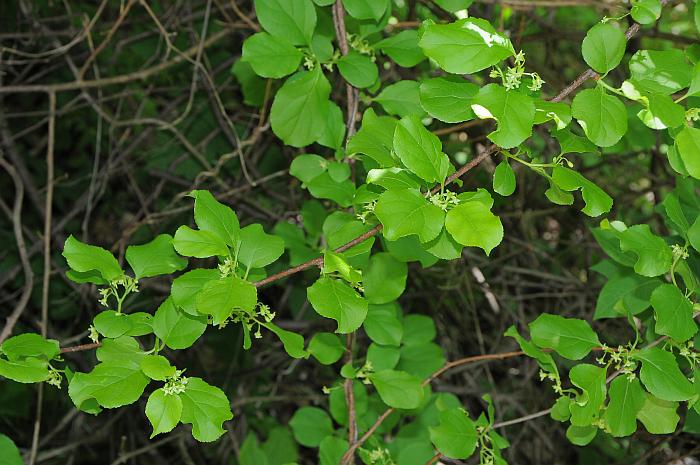Celastrus orbiculatus Thunb.
Oriental Bittersweet

Introduced
CC = *
CW = 5
MOC = 14
© SRTurner
Celastrus orbiculatus Thunb.Oriental Bittersweet | |
 |
Introduced CC = * CW = 5 MOC = 14 |
© SRTurner |
|
Family - Celastraceae Habit - Liana, perennial, sometimes incompletely or completely dioecious. Stem - Stems to 20 m, twining on other vegetation, circular in cross section. Bark dark brown.
Leaves - Alternate, simple, petiolate. Blades variable, even on the same plant, but those on flowering branches usually broadly elliptic to nearly orbicular. Margins toothed, leaf surfaces glabrous or nearly so.
Inflorescence - Axillary clusters. Staminate flowers can also be terminal.
Flowers - Flowers usually imperfect. Sepals 5, 1.0-1.5 mm long. Petals 5, 3-5 mm long, narrowly oblong, rounded at the tip, greenish. Staminate flowers with 5 stamens, the filaments 1.5-2.0 mm long. Pistillate flowers with minute staminodes, the ovary usually with 3 locules and 2 ovules per locule. Style short, stout, the stigma deeply 3-lobed.
Fruits - Fruits roughly globose, 8-9 mm in diameter, 3-lobed, dehiscent by 3 valves, these with the outer surface yellow at maturity, the inner surface orangish yellow. Seeds 4-5 mm long, ovoid to ellipsoid, 3-6, each enclosed in a fleshy red aril.
Flowering - May - June. Habitat - Bottomland or mesic forest and margins. Origin - Native to eastern Asia. Lookalikes - Celastrus scandens. Other info. - This species of Celastrus is an invader in our state. In many habitats it is more aggressive than the native bittersweet, C. scandens, and has become far more common than the native in some areas. It proliferates by root suckers and can blanket and smother other vegetation. This species is distinguished from the native by its broad, often nearly circular leaves, and also by having most flowers in axillary, rather than terminal, clusters. The fruit valves are also yellow, rather than the orange color of the native's fruit valves. Yatskievych's Flora of Missouri describes the inflorescence clusters as having 2-5 flowers. Although it is easy to find super clusters which greatly exceed that number, this is generally due to multiple clusters being present at a node (each cluster being joined to the main stem by a single peduncle). Photographs taken at Babler State Park, St. Louis County, MO, 5-2-2017 and 11-4-2011 (SRTurner). |